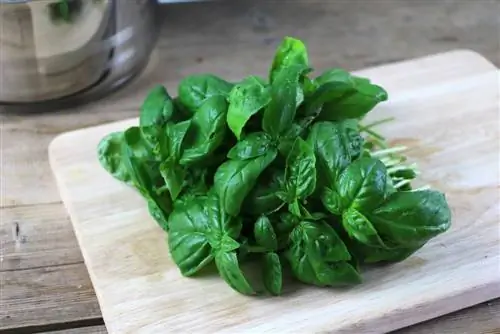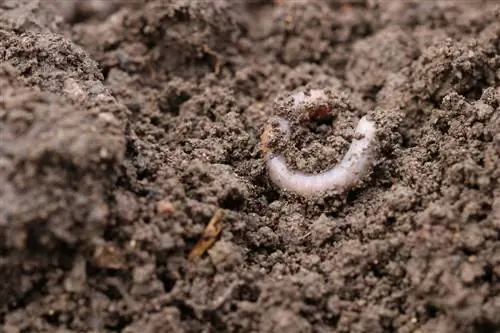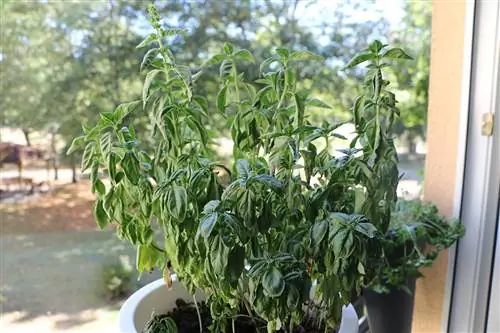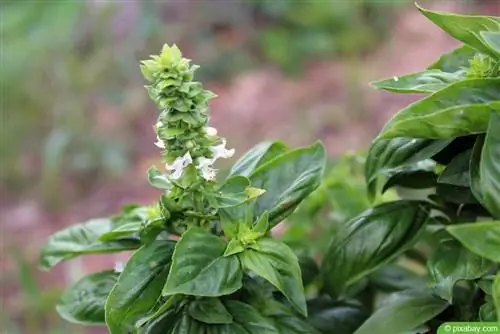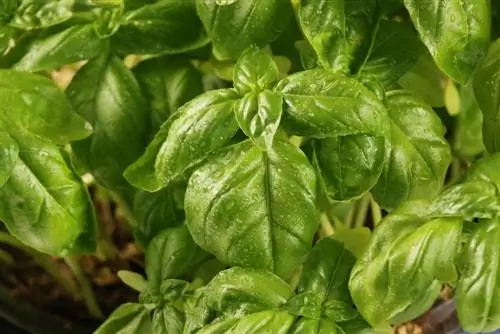- Author admin [email protected].
- Public 2023-12-17 03:39.
- Last modified 2025-06-01 06:48.
In many households, basil is kept in pots. The plants are often taken when shopping and then completely used up or die due to a lack of care. It is quite easy to cultivate royal herb even in smaller containers. If the location is right, a copy can even be preserved for several years and used permanently in the kitchen or elsewhere.
Profile
- Genus: Basil (Ocimum)
- Family: Mint family (Lamiaceae)
- Common names: royal herb, basil, basil herb
- upright growing herb, annual or perennial depending on the husbandry
- Growth height: 20 - 60 cm
- Leaves: elongated leaves with toothed or smooth edges, colored differently depending on the species
- Flower: zygomorphic false whorls in annual inflorescences, colored differently depending on the species, mostly white
- Flowering time: early June to mid-September
- Origin: northwestern India (not confirmed with certainty)
- is used as a culinary herb due to its ingredients
Buy pre-grown potted plants
The necessary care measures when keeping kingweed are much more difficult if you have purchased a weakened specimen. Typically the spice is purchased in the supermarket. However, these specimens are bred exclusively for quick consumption. If you want to enjoy your Basilia for longer, you should, if possible, purchase plants from a nursery or specialist retailer. Weekly markets are just as suitable. Pay attention to the following points when choosing:
- dried substrate
- Stems and leaves light green
- weak aroma
- Pest Infestation
- Leaf discoloration
- rotting smell

If it is only a dry substrate, weak aromas or light green plant material, you can safely purchase the plant and spice it up again. There are seven species and subspecies to choose from:
- Basil (bot. Ocimum basilicum)
- Bush basil (bot. Ocimum minimum)
- Tulsi (bot. Ocimum sanctum)
- Horapa (bot. Ocimum basilicum var. thyrsiflora)
- Lemon basil (bot. Ocimum citriodorum)
- Tree basil (bot. Ocimum gratissimum)
- African basil (bot. Ocimum kilimanscharicum)
Take your time when choosing, as each type has different properties and aroma. The lemon basil delights with a fresh citrus aroma, while the horapa is reminiscent of anise or licorice.
Location
An important point for the successful cultivation of Basilia in the pot is the location. Since Basilicum is a genus from the tropics, it is important to adapt the location to the herb's requirements. This is the only way to ensure good growth and strong aroma development. The cookie for the royal herb should have the following properties regardless of each type:
- Light requirement: sunny
- Penal shade tolerated for short periods
- warm
- Minimum temperature: 12°C
- protected
It is important not to leave the plant behind the glass all the time. Basilia likes a place in the fresh air and especially enjoys the summer outdoors. If you can make this possible, you will enjoy a rich harvest and fragrant herbs on the balcony, terrace or in the garden. If you have just bought and repotted your plant, you should not put it in the sun too much over the first week, but rather slowly get used to it. This will prevent the leaves from drying out and possible sunburn. The plant first has to adjust to the increased amount of light.
Substrate
It's not just the location that is essential for keeping and cultivating basil in pots. In order to provide the mint family with sufficient moisture, nutrients and a good stand, the substrate is just as important. The herb needs a special substrate composition in order to be able to establish itself in it, which increases its vitality and makes overwintering easier. Design the substrate as follows:
- easy
- permeable
- nutrient-rich
- humos
- pH value: 6.5 - 7.2
- high quality
As you can see, basil must be planted in soil that primarily protects against waterlogging, as the plant is very sensitive to this. A combination of humus-rich herbal soil, which you enrich with sufficient compost, is well suited for an ideal structure and supply. Herbal soil has the advantage that it is not too firm and therefore ensures an effective fit and good permeability. That's exactly what basil wants.
Repotting
As already mentioned above, repotting is an important step in the care of basil and is not only necessary for newly acquired specimens. While repotting should be done immediately after purchase, it is important to move the plant to a larger pot whenever the old one is too small. This should also be the case with compacted or old substrate that has problems storing nutrients. If you want to repot in spring, you should do so in May. What is important for this is a new planter that is larger than the old one and has drainage holes. When moving the plant to fresh substrate, proceed as follows:
- Create drainage
- Drainage material: gravel
- fill in a little substrate
- Releasing Basilia from old earth
- Carefully shake off the soil
- Check root
- remove dried, dead or rotten roots
- carefully place in new pot
- fill with substrate
- press gently
- moisten well
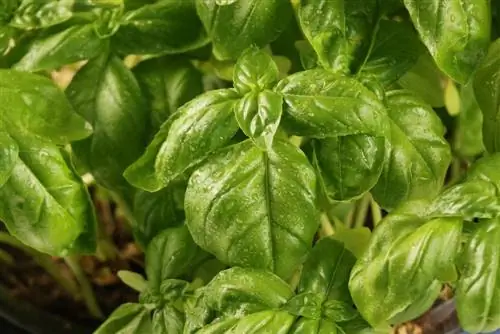
If you have a very large plant, it is best to divide it. More than ten main stems in one container are not recommended due to the lack of space, unless you have a lot of space available in the container. If you divide the plant, you don't necessarily need larger pots, just fresh substrate.
Care
A big advantage of cultivating royal herb is the manageable care. Although it requires a lot of care because it is a tropical plant, once the rhythm is established, care becomes much easier. You need to pay particular attention to adding water and overwintering. If the plant is not cared for as necessary, the royal herb quickly suffers from diseases and pests. But these can also be combated.
Pouring
Basil is a tropical plant and is highly dependent on sufficient moisture. For this reason, you need to water them regularly to ensure the supply of moisture. Besides, you have to be careful not to let the plant drown. Waterlogging quickly leads to a variety of problems with basil, especially in the pot. The following points will help you with watering:
- water more often when there is a lot of sun
- watering when the substrate surface is dry
- Use finger test
- administer small amounts of water
The water should never remain standing in the coaster. It's best to pour this off after a few minutes so that the moisture doesn't collect too much and end up with rotten roots that can destroy the entire plant. It is best to use low-lime water for watering, as basil can only tolerate small amounts of lime. The following are well suited for this:
- stale tap water
- Filter water
- Rainwater
When watering, you should never pour directly onto the kingweed. This increases the risk of fungal diseases and, in strong sunshine, burns to the leaves. Only the substrate is watered so that this danger can be contained.
Note:
Never place your basil pot in the rain. In most cases this leads to waterlogging and can severely damage the plant, which makes rain protection very important in summer.
Fertilize
Like many other plants from tropical areas of the world, it is important for kingweed to provide it with nutrients at the necessary times with the right fertilizer. In order for the basil to develop its intense aroma and at the same time maintain its vitality, regular fertilization is necessary throughout the year. Even in winter you fertilize because the crop doesn't really take a winter break, especially not when you harvest it. Fertilizing works as follows:
- Frequency: 2 - 4 weeks
- use high-quality herbal liquid fertilizer
- administer via irrigation water
- ideally fertilize in the morning
The liquid fertilizer is much better suited for fertilizing, as it can be administered more easily with the irrigation water and is distributed more quickly in the substrate. You should fertilize in the morning so that the midday sun does not burn the fertilizer into the substrate. When you fertilize, the fertilizer, like the irrigation water, is not applied to the leaves.
Note:
If you want to harvest your Ocimum specimens regularly and cultivate them over a period of several years, you should only fertilize with organic-based products. This prevents the ingestion of chemicals that could negatively impact your he alth.
Cutting
In addition to fertilizing and watering, cutting the basil is another essential care step. The most important thing is to prevent the basil from forming flowers, otherwise the aroma of the leaves will noticeably decrease. During flowering they even take on a strong bitter aroma. Depending on your preference, cutting takes place all year round, with increased frequency over the summer. Only cut off the shoot tips and never into the woody part of the perennial basil. Always leave the lowest pair of leaves on each shoot to encourage new growth. This will also help you keep the basil in check if it grows too quickly.
Tip:
If you want to use the basil in the garden as an insect pasture, save yourself the pruning in spring and wait for it to bloom. Shortly before the end of flowering, simply cut the royal herb and use the flowers to make vinegar or as part of a salad, as they are edible.
Wintering
Overwintering protects Ocimum from the low temperatures that prevail over the winter in Central Europe. Proceed as follows:
- move inside at temperatures below 15°C
- Winter quarters temperature: 15°C - 20°C
- bright
- protected from drafts
- do not place above radiators
Sufficient humidity is very important during this period, otherwise the royal herb will suffer from dryness. Use a spray bottle or an automatic humidifier for this. If you have problems with enough light, it is best to use grow lights until spring arrives.
Propagate
Yes, basil plants can be propagated by sowing or cuttings in addition to division. If you plan to sow seeds, you will either need to let the plant flower or purchase seeds:
- Time of sowing: April
- Substrate: 2 parts potting soil, 1 part sand
- moisturize
- fill into cultivation container
- max. twelve seeds per container
- place on earth
- press lightly
- Cover the cultivation container
- use cling film for this
- alternative mini greenhouse
- Temperature: 20°C - 25°C
- Location: bright
- ventilate daily
- Keep substrate moist
- Seeds germinate quite quickly
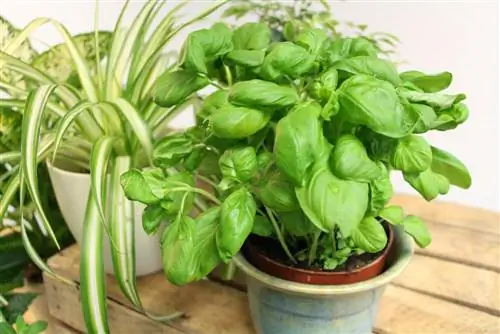
The seedlings are then selected and placed in their own pots with suitable substrate. The cuttings, on the other hand, can be used for propagation all year round. These should be ten centimeters tall and have one or two pairs of leaves. After two to three weeks in a glass of water, roots should have developed, which allows planting in a pot (maximum of ten cuttings per container).
Pests and diseases
Basil is quite resistant despite its origin, but can quickly suffer from fungal or viral diseases. If the herb suffers from one of the following fungal diseases, you must immediately remove the affected parts of the plant and dispose of them in the trash. Chemical agents are not applicable as Ocimum is used for consumption.
Stem root rot
It is caused by waterlogging and can destroy the entire plant as the roots rot and an unpleasant smell can be heard. The stems can also take on a different color. Unfortunately, in this case you have to destroy the entire plant so that the fungus doesn't spread any further.
Leaf spot disease
Spots in yellow or brown-red are caused by moisture on the leaves. The basil will recover quickly if the leaves are removed. The individual spots can run into each other, which weakens the plant greatly.
Alfalfa mosaic virus
If you see yellowed leaves and spots in a mosaic pattern, it is this viral infection. Aphids and leaves with deformations or compression can also be seen. If the infestation is severe, destroy all of the herb. Otherwise, fight aphids and remove infected areas.
Fusarium wilt
This serious fungal disease with a fatal outcome for the plant can be recognized by the yellowing of the leaves, mainly the older ones. The plant also weakens significantly. Over time, the herb simply dies and there is no countermeasure.
Pest infestations can also be recorded when kept in the garden. These mainly include snails and the caterpillars of the dock owl (Acronicta rumicis), which like to feast on the leaves. You can keep snails away with a snail guard while the moth caterpillars are collected and infested parts are disposed of.
Tip:
Don't worry, a woody stem is not a sign of disease or pest infestation if the leaf and stem color remains intact. All types of basil are woody plants that grow very robustly with years of good care and therefore the woodiness is a positive aspect if the plant is doing well in the pot.

